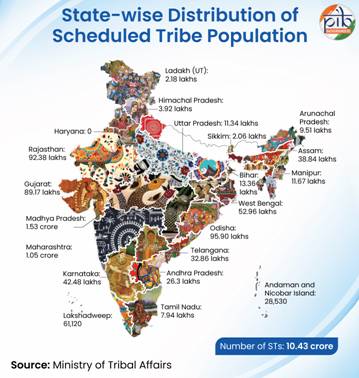Tradition, Culture, Religion & Law in Indian Society
Re: Tradition, Culture, Religion & Law in Indian Society
“Civilizations Do Not Fall By Swords”: Gautam Adani Warns Against Attacks On India’s Cultural Memory
At the Adani Global Indology Conclave 2025, Gautam Adani warned that civilizations “do not fall by swords alone” but collapse when cultural memory is attacked. Citing the destruction of Nalanda and other ancient universities, and Macaulay’s colonial overhaul of India’s knowledge systems, Adani said the real damage came from erasing confidence and stealing intellectual heritage. He stressed that safeguarding cultural memory is essential to protecting a civilization’s future.
At the Adani Global Indology Conclave 2025, Gautam Adani warned that civilizations “do not fall by swords alone” but collapse when cultural memory is attacked. Citing the destruction of Nalanda and other ancient universities, and Macaulay’s colonial overhaul of India’s knowledge systems, Adani said the real damage came from erasing confidence and stealing intellectual heritage. He stressed that safeguarding cultural memory is essential to protecting a civilization’s future.
Re: Tradition, Culture, Religion & Law in Indian Society
https://x.com/ssaratht/status/1992490911692132784
@ssaratht
This Stalin family is a periyar worshipper.
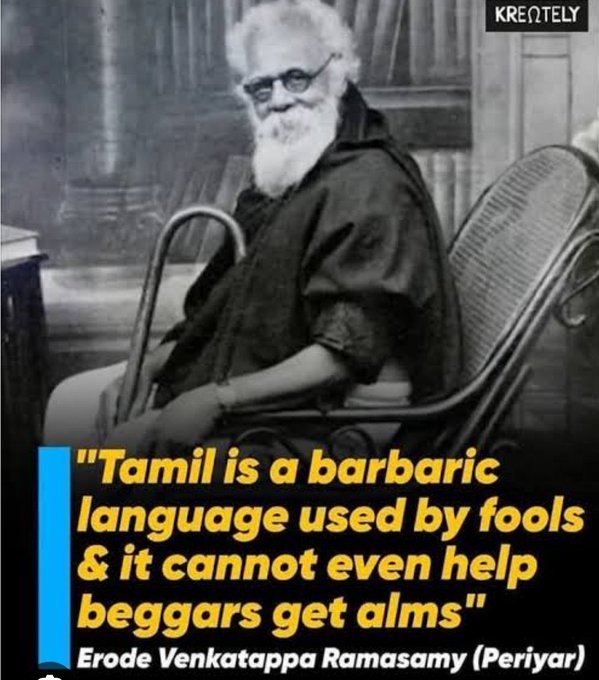
@ssaratht
This Stalin family is a periyar worshipper.

Re: Tradition, Culture, Religion & Law in Indian Society
https://x.com/tapeshyadav_usa/status/19 ... 1698374856
@tapeshyadav_usa
Oh CANADA! – Misrepresenting Hindu Art at Glenbow Museum, Calgary
Some western museums and art dealers grossly misrepresent Hindu art. Example: Below is a photo of original c. 5th/6th-century Ramayana art. Glenbow museum labeled the scene below as "Sita" with Hanuman.
Shocking. Wrong. Gross negligence too, because it has two inscriptions. Left says: "Simhika", Right: Hanu/Ma. Simhika is the demoness who tries to stop Hanuman from crossing over to Lanka. When questioned about this nonsense, Glenbow curators blamed the Art Dealer's info.
Source: Laxshmi Greaves (2018), Locating the Lost Gupta Period Ramayana Reliefs from Katingara, Uttar Pradesh
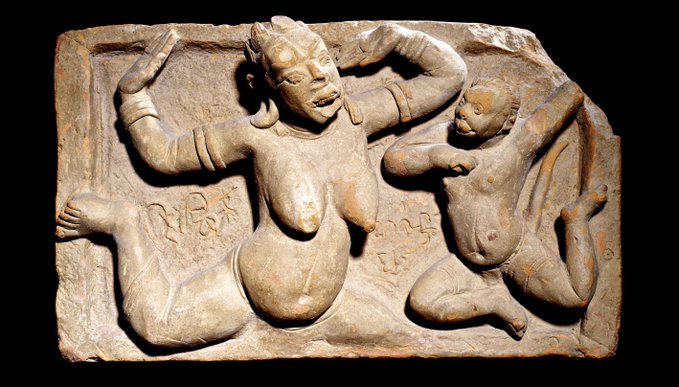
@tapeshyadav_usa
Oh CANADA! – Misrepresenting Hindu Art at Glenbow Museum, Calgary
Some western museums and art dealers grossly misrepresent Hindu art. Example: Below is a photo of original c. 5th/6th-century Ramayana art. Glenbow museum labeled the scene below as "Sita" with Hanuman.
Shocking. Wrong. Gross negligence too, because it has two inscriptions. Left says: "Simhika", Right: Hanu/Ma. Simhika is the demoness who tries to stop Hanuman from crossing over to Lanka. When questioned about this nonsense, Glenbow curators blamed the Art Dealer's info.
Source: Laxshmi Greaves (2018), Locating the Lost Gupta Period Ramayana Reliefs from Katingara, Uttar Pradesh

Re: Tradition, Culture, Religion & Law in Indian Society
https://x.com/MumukshuSavitri/status/19 ... 4039784701
@MumukshuSavitri
It’s a documented fact that the Caste system itself was invented outside India - a purely European invention called “Sistema de Casta“ practiced by them for centuries.
"Casta" is a Spanish word meaning lineage documented since 1417. It is the root of the English word caste. Spanish & Portuguese invented this hierarchical race-based "caste system" rooted in concept of purity of blood called "Limpieza de sangre", to identify anyone with Jewish or Muslim heritage to persecute them during the Christian Inquisition. The OG caste system invented by them was called “Sistema de Casta”.
They created an entire genre of disgusting racist Casta paintings to show their racist caste system where they believed the darker your skin, the stupider and more savage you were. Anyone with blood linked to dark skin was classified as a ”stain" by them. Most Indians would be called a “stain” by them because we have the genetic heritage of darker skin than them.
Casta paintings depicted the supposed "innate" character & quality of people connected to their birth and skin color. In a painting by José Joaquín Magón, a mestizo (mixed Indian + Spanish) was labelled “humble, meek, and docile” because of darker skin than Whites. Casta paintings such as this by Ignacio Barreda (1777) showed white Spainards at highest social status & dark skinned as more “uncivilized at a lower status.” Entire categories of vile racist discrimination based on skin color were institutionalized by bigoted Europeans in their Casta system.
When Portuguese came to India they simply transposed their word “Casta” from Sistema De Casta (caste system) to classify Indian endogamous groups with hereditary occupations.
I challenge anyone to find a single Indian text with the word “caste” in it before Portuguese came to India.
Moronic Indians who hate their own civilization perpetuated their utterly stupid lies - & the rest is history.


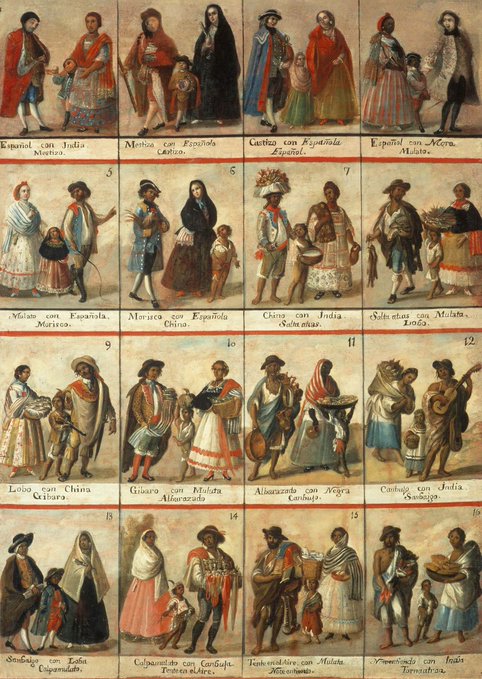
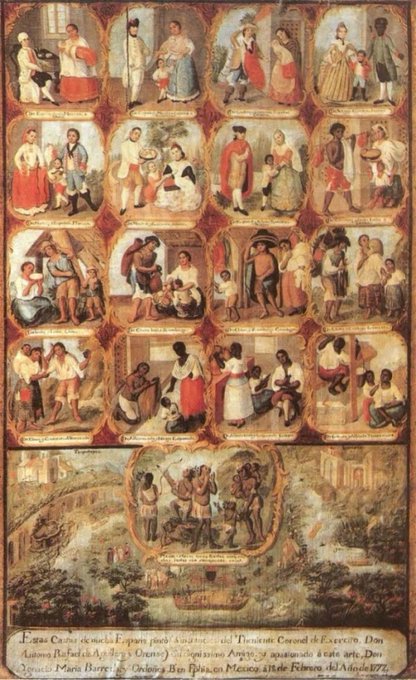
@MumukshuSavitri
It’s a documented fact that the Caste system itself was invented outside India - a purely European invention called “Sistema de Casta“ practiced by them for centuries.
"Casta" is a Spanish word meaning lineage documented since 1417. It is the root of the English word caste. Spanish & Portuguese invented this hierarchical race-based "caste system" rooted in concept of purity of blood called "Limpieza de sangre", to identify anyone with Jewish or Muslim heritage to persecute them during the Christian Inquisition. The OG caste system invented by them was called “Sistema de Casta”.
They created an entire genre of disgusting racist Casta paintings to show their racist caste system where they believed the darker your skin, the stupider and more savage you were. Anyone with blood linked to dark skin was classified as a ”stain" by them. Most Indians would be called a “stain” by them because we have the genetic heritage of darker skin than them.
Casta paintings depicted the supposed "innate" character & quality of people connected to their birth and skin color. In a painting by José Joaquín Magón, a mestizo (mixed Indian + Spanish) was labelled “humble, meek, and docile” because of darker skin than Whites. Casta paintings such as this by Ignacio Barreda (1777) showed white Spainards at highest social status & dark skinned as more “uncivilized at a lower status.” Entire categories of vile racist discrimination based on skin color were institutionalized by bigoted Europeans in their Casta system.
When Portuguese came to India they simply transposed their word “Casta” from Sistema De Casta (caste system) to classify Indian endogamous groups with hereditary occupations.
I challenge anyone to find a single Indian text with the word “caste” in it before Portuguese came to India.
Moronic Indians who hate their own civilization perpetuated their utterly stupid lies - & the rest is history.




Re: Tradition, Culture, Religion & Law in Indian Society
Cross posting from Modi 3.0
India Pushes Gita Diplomacy Worldwide As Jaishankar Highlights Kurukshetra Mahotsav’s Growing Reach
India has launched one of its biggest cultural diplomacy missions yet, and External Affairs Minister S Jaishankar is leading it from the front. Speaking at the International Gita Mahotsav in Kurukshetra, he announced that more than 50 Indian missions across the world are hosting parallel celebrations to take the message of the Bhagavad Gita global. The festival, now a growing international movement, showcases India’s civilizational depth and the modern relevance of Lord Krishna’s teachings. With exhibitions, translated editions, cultural programs, and foreign scholars joining worldwide, the Gita Mahotsav is becoming a platform for unity, harmony, and shared values. As Kurukshetra prepares for massive participation and PM Modi’s visit, India is sending a clear message: the world’s oldest philosophies still shape the world’s newest power.
India Pushes Gita Diplomacy Worldwide As Jaishankar Highlights Kurukshetra Mahotsav’s Growing Reach
India has launched one of its biggest cultural diplomacy missions yet, and External Affairs Minister S Jaishankar is leading it from the front. Speaking at the International Gita Mahotsav in Kurukshetra, he announced that more than 50 Indian missions across the world are hosting parallel celebrations to take the message of the Bhagavad Gita global. The festival, now a growing international movement, showcases India’s civilizational depth and the modern relevance of Lord Krishna’s teachings. With exhibitions, translated editions, cultural programs, and foreign scholars joining worldwide, the Gita Mahotsav is becoming a platform for unity, harmony, and shared values. As Kurukshetra prepares for massive participation and PM Modi’s visit, India is sending a clear message: the world’s oldest philosophies still shape the world’s newest power.
Re: Tradition, Culture, Religion & Law in Indian Society
Rajiv Malhotra Reveals 108 Frameworks
Rajiv Malhotra introduces 108 frameworks of Indian thought - decades of debates, encounters, and challenges crystallized into structured frameworks. Fragmented training data leads to contradiction and why frameworks solve this based on the most important aspects of Indian School of Thought. Drawing on decades’ of experience, Rajiv says these frameworks represent a bold, coherent, and original school of thought rooted in Vedic first principles — yet designed to engage the modern world with intellectual sharpness, strategic clarity, and cultural confidence. The 108 frameworks systematizes Indic knowledge into a living, evolving civilizational toolkit.
Rajiv Malhotra introduces 108 frameworks of Indian thought - decades of debates, encounters, and challenges crystallized into structured frameworks. Fragmented training data leads to contradiction and why frameworks solve this based on the most important aspects of Indian School of Thought. Drawing on decades’ of experience, Rajiv says these frameworks represent a bold, coherent, and original school of thought rooted in Vedic first principles — yet designed to engage the modern world with intellectual sharpness, strategic clarity, and cultural confidence. The 108 frameworks systematizes Indic knowledge into a living, evolving civilizational toolkit.
Re: Tradition, Culture, Religion & Law in Indian Society
https://x.com/Ofer_binshtok/status/1993467333528940780
@Ofer_binshtok
Research: 803 Million Missing Hindu Souls (700-2025) – A Demographic Audit
The Indian Subcontinent
By Ofer Binshtok
They tell you Hindus are 1.26 billion today.
That’s a lie by omission.
Without 1300 years of industrial-scale slaughter and enslavement, we would be almost 2.1 billion today, bigger than China, bigger than the entire Muslim world.
803 million of us are simply gone.
Tens of millions were butchered in cold blood. Millions more were abducted as children, castrated, marched through the Hindu Kush and sold into slavery. The rest, hundreds of millions, were never born because entire bloodlines were exterminated centuries ago.
This is not a “demographic deficit.”
This is the largest Blood Tax ever imposed on any civilization in recorded history.
Every excuse collapses instantly.
British colonialism?
The bloodletting began in 712 CE, one thousand years before the British arrived.
Climate or soil?
The Ganges plain is more fertile than the Yellow River. China still grew ×29.5 since 700 CE despite worse land. We used the most conservative benchmark.
Only one force ruled the Indian Subcontinent, and never China, for eleven straight centuries:
Islamic conquest, Jihad and theocratic domination.
Carried out through three documented mechanisms:
Ghazwa: ritual holy war and mass murder
Hindu-Kush slave trade: millions of breeding-age Hindus erased forever
Jizya: economic strangulation until conversion or death
803 million Hindu souls. Killed. Enslaved. Prevented from ever being born.
The numbers do not lie.
The graph does not lie.
The blood still screams from the earth.
(See attached graph, the final indictment)
Full forensic report and sources in the first comment below.
If you have another explanation, bring it.
We’re waiting.
Note on Statistical Variance:
Historical demography over millennial timescales inherently involves margins of error due to variations in baseline estimates and modeling techniques across different academic sources. A standard statistical deviation range of ±5–10% applies to these projections. However, even accounting for maximum deviation, the scale of the demographic deficit remains catastrophic and in the range of hundreds of millions, reinforcing the fundamental conclusion of systemic suppression.
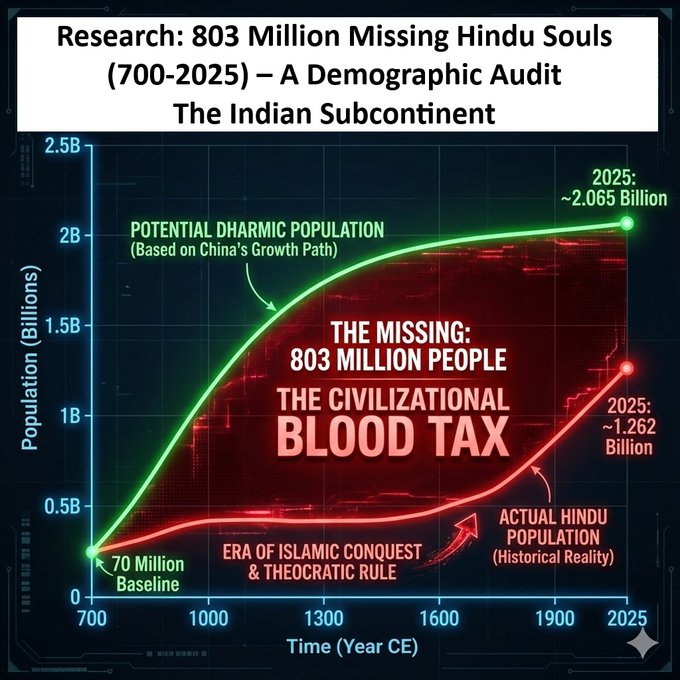
@Ofer_binshtok
Research: 803 Million Missing Hindu Souls (700-2025) – A Demographic Audit
The Indian Subcontinent
By Ofer Binshtok
They tell you Hindus are 1.26 billion today.
That’s a lie by omission.
Without 1300 years of industrial-scale slaughter and enslavement, we would be almost 2.1 billion today, bigger than China, bigger than the entire Muslim world.
803 million of us are simply gone.
Tens of millions were butchered in cold blood. Millions more were abducted as children, castrated, marched through the Hindu Kush and sold into slavery. The rest, hundreds of millions, were never born because entire bloodlines were exterminated centuries ago.
This is not a “demographic deficit.”
This is the largest Blood Tax ever imposed on any civilization in recorded history.
Every excuse collapses instantly.
British colonialism?
The bloodletting began in 712 CE, one thousand years before the British arrived.
Climate or soil?
The Ganges plain is more fertile than the Yellow River. China still grew ×29.5 since 700 CE despite worse land. We used the most conservative benchmark.
Only one force ruled the Indian Subcontinent, and never China, for eleven straight centuries:
Islamic conquest, Jihad and theocratic domination.
Carried out through three documented mechanisms:
Ghazwa: ritual holy war and mass murder
Hindu-Kush slave trade: millions of breeding-age Hindus erased forever
Jizya: economic strangulation until conversion or death
803 million Hindu souls. Killed. Enslaved. Prevented from ever being born.
The numbers do not lie.
The graph does not lie.
The blood still screams from the earth.
(See attached graph, the final indictment)
Full forensic report and sources in the first comment below.
If you have another explanation, bring it.
We’re waiting.
Note on Statistical Variance:
Historical demography over millennial timescales inherently involves margins of error due to variations in baseline estimates and modeling techniques across different academic sources. A standard statistical deviation range of ±5–10% applies to these projections. However, even accounting for maximum deviation, the scale of the demographic deficit remains catastrophic and in the range of hundreds of millions, reinforcing the fundamental conclusion of systemic suppression.

Re: Tradition, Culture, Religion & Law in Indian Society
https://x.com/GemsOfINDOLOGY/status/1993190199426429037
@GemsOfINDOLOGY
Gaze at these stone reliefs: a warrior dispatching his enemy, a woman methodically tying her hair—evoking 𝐃𝐫𝐚𝐮𝐩𝐚𝐝𝐢'𝐬 grim resolve post-Dushasana's fall in the Mahabharata, or perhaps a kindred tale from ancient lore?
Carvings like these blend vengeance with dharma's shadows, outlasting faded texts yet sparking debates on their true origins. What layered myths do they guard against simplistic retellings?
Hampi
@GemsOfINDOLOGY
Gaze at these stone reliefs: a warrior dispatching his enemy, a woman methodically tying her hair—evoking 𝐃𝐫𝐚𝐮𝐩𝐚𝐝𝐢'𝐬 grim resolve post-Dushasana's fall in the Mahabharata, or perhaps a kindred tale from ancient lore?
Carvings like these blend vengeance with dharma's shadows, outlasting faded texts yet sparking debates on their true origins. What layered myths do they guard against simplistic retellings?
Hampi
Re: Tradition, Culture, Religion & Law in Indian Society
Govt press release
https://www.pib.gov.in/PressReleasePage ... ID=2194540
https://www.pib.gov.in/PressReleasePage ... ID=2194540
With over 705 unique tribal groups making up 8.6% of its population, India is home to a vibrant heritage of unique traditional arts and handicrafts preserved by these communities.
At the 44th India International Trade Fair in New Delhi, India’s rich tribal artforms are being honoured to commemorate ‘Ek Bharat: Shrestha Bharat’ (‘One India: Great India’).
At the Fair, tribal groups from across the country are exhibiting their work to a wider audience, supported by the Government of India and state governments.
Promotion of India’s tribal art and handicrafts ensures that these age-old traditions survive the test of time and contribute to the inclusive socio-economic development of India, as the country positions itself to be a $5 trillion economy by 2047.
Re: Tradition, Culture, Religion & Law in Indian Society
https://x.com/mishmanaged_/status/1993376576155595230
@mishmanaged_
Gada, a traditional indian training tool used for over 3000 years in martial arts and kusti is now rebranded as “Macebell Training”.
Just like Yoga, Clothes, Food and many more things, even this doesn’t get the right credit.
@mishmanaged_
Gada, a traditional indian training tool used for over 3000 years in martial arts and kusti is now rebranded as “Macebell Training”.
Just like Yoga, Clothes, Food and many more things, even this doesn’t get the right credit.
Re: Tradition, Culture, Religion & Law in Indian Society
https://x.com/MumukshuSavitri/status/19 ... 4683425168
@MumukshuSavitri
Devdutt’s original post against Chanakya:
954.4 K views
3.5 K likes
1.3K RTs
My rebuttal to his lies:
64.6K views
1.7 K likes
772 RTs
It's becoming increasingly clear that the problem lies with the algorithm which ensures that posts by strident Hindu voices like mine are made less visible so that our audience doesn't even get to see them.
Sad that Hindus have to deal with this kind of subtle censorship on SM platforms
@MumukshuSavitri
Devdutt’s original post against Chanakya:
954.4 K views
3.5 K likes
1.3K RTs
My rebuttal to his lies:
64.6K views
1.7 K likes
772 RTs
It's becoming increasingly clear that the problem lies with the algorithm which ensures that posts by strident Hindu voices like mine are made less visible so that our audience doesn't even get to see them.
Sad that Hindus have to deal with this kind of subtle censorship on SM platforms
Re: Tradition, Culture, Religion & Law in Indian Society
https://x.com/LevinaNeythiri/status/1993574340252909754
@LevinaNeythiri
Goosebumps
You are not a SANATANI if your brain doesnt not send out a signal to nod your head with the BEATS of Panchari melam.
Loc: Sree Poornathrayeesa Temple in (Tripunithura, Kerala)
VrishchikalUlsavam— meaning the festival of Vrishchikam month.
Credit: Kshethra_media
@LevinaNeythiri
Goosebumps
You are not a SANATANI if your brain doesnt not send out a signal to nod your head with the BEATS of Panchari melam.
Loc: Sree Poornathrayeesa Temple in (Tripunithura, Kerala)
VrishchikalUlsavam— meaning the festival of Vrishchikam month.
Credit: Kshethra_media
Re: Tradition, Culture, Religion & Law in Indian Society
https://x.com/swamin400/status/1993354171240923367
@swamin400
Even after 3 years of my previous post
When a Hoysala-era temple that stood in the time of King veera Ballala III is reduced to this condition… and that too in Jigani, Bengaluru, right beside a Government Veterinary Hospital…
we are truly at a loss for words.
This is the Varadaraja Swamy Temple — a silent witness to 700+ years of history
Today it stands neglected, vulnerable, and forgotten.
If a Hoysala monument in Namma Bengaluru itself cannot be protected, what message does it send for the rest of Karnataka’s heritage?
Can anyone save this priceless legacy?
Appealing to authorities and heritage lovers to intervene before it vanishes forever.
@swamin400
Even after 3 years of my previous post
When a Hoysala-era temple that stood in the time of King veera Ballala III is reduced to this condition… and that too in Jigani, Bengaluru, right beside a Government Veterinary Hospital…
we are truly at a loss for words.
This is the Varadaraja Swamy Temple — a silent witness to 700+ years of history
Today it stands neglected, vulnerable, and forgotten.
If a Hoysala monument in Namma Bengaluru itself cannot be protected, what message does it send for the rest of Karnataka’s heritage?
Can anyone save this priceless legacy?
Appealing to authorities and heritage lovers to intervene before it vanishes forever.
Re: Tradition, Culture, Religion & Law in Indian Society
https://x.com/GemsOfINDOLOGY/status/1993567951740604885
@GemsOfINDOLOGY
THREAD: How Bengaluru Buried 3,000 Years Under Asphalt
1/ Take a moment. Picture Chikkajala—a megalithic burial site predating empires we revere. Unearthed by Captain Branfil in colonial times, packed with Iron Age cists (500-1000 BCE) and striking black-and-red pottery. Priceless for science. Until we paved it over. What a legacy, eh?
@GemsOfINDOLOGY
THREAD: How Bengaluru Buried 3,000 Years Under Asphalt
1/ Take a moment. Picture Chikkajala—a megalithic burial site predating empires we revere. Unearthed by Captain Branfil in colonial times, packed with Iron Age cists (500-1000 BCE) and striking black-and-red pottery. Priceless for science. Until we paved it over. What a legacy, eh?
Re: Tradition, Culture, Religion & Law in Indian Society
https://x.com/tapeshyadav_usa/status/19 ... 8573839470
@tapeshyadav_usa
INDIA'S PROSPERITY BEFORE ISLAM: Evidence from Cairo Geniza (1060–1260 AD)
Long before the first Sultan sat in Delhi, the Indian Ocean was the highway of world trade. India stood at its heart.
Proof: Jewish papers written in Judeo-Arabic.
In Cairo’s historic Ben Ezra Synagogue, 200,000 pages lay forgotten in a geniza over 1000 years. Among them: contracts, letters, dowry lists, tax receipts—and many folios on India.
Scholars at Cambridge Univ have published some of these India fragments (Goitein's "India Book").
These pages list what India produced and exported before any army crossed the Indus to found the Delhi Sultanate.
What India exported to Aden, Cairo, and beyond?
1⃣Raw and simple goods:
Copper, bronze, iron, rice, wheat, oil, vinegar, lemon, ginger, coconut, ghee, sugar, betel nuts, spices, dyes, lacquer, etc.
2⃣Finished goods
Textiles, ready made clothes, scarves, robes, dyed leather, shoes, furniture, carpets, iron and copper lamps, pots, pans, bowls, glasses, teak boards, locks, bedsteads, table jugs, etc.
3⃣Beauty and fashion
Soap (sabun), perfumes, musk, pearls, gems, bracelets, necklaces, silk robes, ornamented mirrors, silver boxes, belts, earrings, jewelry, etc
4⃣Repair work
Broken luxury items from the Middle East were shipped to Indian craftsmen, mended, and sent back.
What India imported in return?
Walnuts, olives, paper, lead, alkali, coral, raisins, dates, cheese, linseed—and silver and gold ingots to pay the bill. Damaged household goods came too, for Indian hands to fix.
The ports: Bharuch (GJ), Thana-Mumbai (MH), Kollam (KL), Malabar coast.
The people:
Jewish letters mention Hindu partners. Jews call them “brother” or “friend.” They trust them with money and family. A Jewish traveller asks his son to lodge with a certain Hindu household on arrival. Hindu names appear as witnesses on Jewish legal contracts.
Hindus and Jews co-own ships. Hindus build ships, repair ships, sail them.
More evidence waits elsewhere: Ajanta and Bagh paintings, temple reliefs, copper-plate grants—all tell the same story of wealth and skill (future s).
s).
Conclusions:
Before 1200 AD, India was the workshop and fashion house of the known world.
If silk robes, jewellery, soap, and fine steel already left Indian ports for Cairo and Aden centuries before Babur was born, what exactly did the Sultanates or Mughals bring that India did not already have? from where did they bring it?
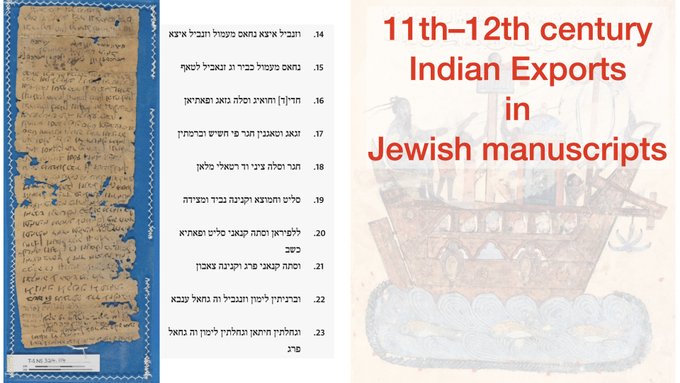
@tapeshyadav_usa
INDIA'S PROSPERITY BEFORE ISLAM: Evidence from Cairo Geniza (1060–1260 AD)
Long before the first Sultan sat in Delhi, the Indian Ocean was the highway of world trade. India stood at its heart.
Proof: Jewish papers written in Judeo-Arabic.
In Cairo’s historic Ben Ezra Synagogue, 200,000 pages lay forgotten in a geniza over 1000 years. Among them: contracts, letters, dowry lists, tax receipts—and many folios on India.
Scholars at Cambridge Univ have published some of these India fragments (Goitein's "India Book").
These pages list what India produced and exported before any army crossed the Indus to found the Delhi Sultanate.
What India exported to Aden, Cairo, and beyond?
1⃣Raw and simple goods:
Copper, bronze, iron, rice, wheat, oil, vinegar, lemon, ginger, coconut, ghee, sugar, betel nuts, spices, dyes, lacquer, etc.
2⃣Finished goods
Textiles, ready made clothes, scarves, robes, dyed leather, shoes, furniture, carpets, iron and copper lamps, pots, pans, bowls, glasses, teak boards, locks, bedsteads, table jugs, etc.
3⃣Beauty and fashion
Soap (sabun), perfumes, musk, pearls, gems, bracelets, necklaces, silk robes, ornamented mirrors, silver boxes, belts, earrings, jewelry, etc
4⃣Repair work
Broken luxury items from the Middle East were shipped to Indian craftsmen, mended, and sent back.
What India imported in return?
Walnuts, olives, paper, lead, alkali, coral, raisins, dates, cheese, linseed—and silver and gold ingots to pay the bill. Damaged household goods came too, for Indian hands to fix.
The ports: Bharuch (GJ), Thana-Mumbai (MH), Kollam (KL), Malabar coast.
The people:
Jewish letters mention Hindu partners. Jews call them “brother” or “friend.” They trust them with money and family. A Jewish traveller asks his son to lodge with a certain Hindu household on arrival. Hindu names appear as witnesses on Jewish legal contracts.
Hindus and Jews co-own ships. Hindus build ships, repair ships, sail them.
More evidence waits elsewhere: Ajanta and Bagh paintings, temple reliefs, copper-plate grants—all tell the same story of wealth and skill (future
Conclusions:
Before 1200 AD, India was the workshop and fashion house of the known world.
If silk robes, jewellery, soap, and fine steel already left Indian ports for Cairo and Aden centuries before Babur was born, what exactly did the Sultanates or Mughals bring that India did not already have? from where did they bring it?

